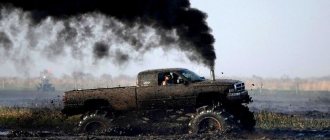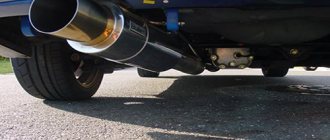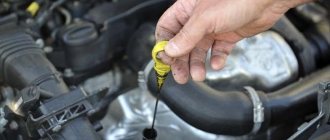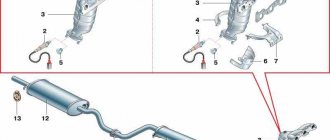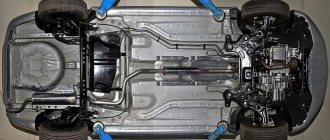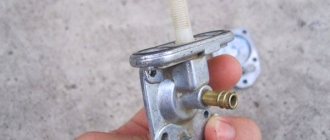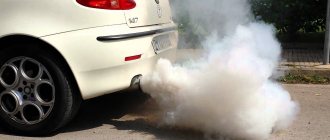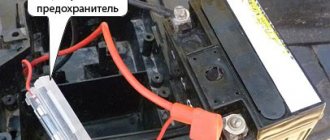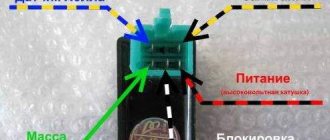Why does the silencer shoot: reasons
The main reason for the appearance of pops is incomplete combustion of fuel.
Once it enters the exhaust system, it ignites. The process is accompanied by a noise similar to cotton. The force of the explosion depends on the amount of unburned fuel. Sometimes you can even hear a whole line of shots. By the way, sometimes it shoots into the muffler when the gas is suddenly released or when you press it - and a lot of smoke comes out of the exhaust pipe. A breakdown is indicated by a loss of internal combustion engine power and an increase in fuel consumption. There are other reasons why popping occurs.
Air filter
The fuel mixture is formed from fuel and air - the components must be mixed in certain proportions. The filter does not allow air to pass through if it is clogged. As a result, the lack of oxygen will lead to incomplete combustion of the fuel. Through the manifold, the fuel enters the exhaust system, where an explosion occurs as a result of heating.
Carburetor
An explosion in the exhaust system can also occur due to incorrect carburetor settings. The purpose of the unit is to form the correct air-fuel mixture. There should not be a lot of fuel in the mixture, otherwise everything described in the previous paragraph will happen. Popping noises will only be heard when the gas is released.
Jets
Jets are filter elements that allow air mass to pass through them. They are used in carburetor engines. There are 2 common causes of malfunction: clogging due to prolonged use and incorrect settings. This leads to a lack of oxygen and incomplete combustion of the fuel - as is the case with air filters. Due to the lack of oxygen, the mixture becomes oversaturated with gasoline - hence the popping noise.
Ignition system
This node also needs to be configured properly. Usually “shots” are a consequence of late ignition. The point is this: a spark is formed when the supply valve is fully opened. This causes fuel to enter the manifold, and then into the exhaust. With early ignition, “shots” can also occur, but only in the air filter. Explosions in the muffler due to late ignition lead to burnout of the intake valve.
Candles
Incomplete combustion of fuel may occur due to insufficient spark. Possible reasons:
- Poor contact at wire terminals.
- Distributor malfunction.
- Spark plug failure. Even one burnt element can seriously affect sparking. As a result, a weak spark will be produced, and the fuel will not burn out completely.
Thermal gap
Thermal gap is the permissible gap between the parts of the motor when heating. It can be observed between the camshaft lobes and valve lifters. The gap must be adjusted according to specifications.
Indirect signs of an increase in the gap are a decrease in engine power and increased noise during operation. Insufficient clearance causes “shots” in the exhaust. The logic of what is happening is as follows: if the valve is not completely closed, part of the fuel will pass through it into the manifold, and from there into the exhaust.
timing belt
If the gas distribution mechanism is not adjusted, popping noises in the exhaust system are inevitable. The problems that precede the failure of the timing belt are similar to the symptoms of an incorrect setting of the ignition system - the exhaust valve opens when the fuel has not yet completely burned out. Unused fuel will end up in the exhaust, which becomes the cause of the “cannonade” described here. Possible causes of the malfunction:
- Worn timing belt drive. In this case, the pops have a metallic tint; at low speeds the engine is too noisy.
- Worn toothed pulley.
- Valve failure. The valves are gradually covered with a layer of carbon deposits. The process is accelerated if low-quality fuel is used. As a result, the valve springs freeze and the engine overheats.
Car breakdowns: why the muffler shoots
It shoots and pops, but not a weapon or a firecracker. It could very well be the muffler of a desperate car. It’s an unpleasant phenomenon when the car jerks, fires the muffler and behaves extremely inappropriately when accelerating. Dips, deterioration of dynamics, increased fuel consumption. If you pay attention to this at the wrong time, the consequences may not be the most pleasant. The muffler burnout is only the most harmless ending to this story. Why the muffler shoots, what affects it and how to deal with it, only practice will tell you.
Shooting with a silencer leads to many unpleasant consequences
Can a popping sound in the muffler damage the engine?
- gas distribution mechanism;
- fuel supply system;
- ignition system;
- ICE sensors (in injection engines).
Popping noises do not pose any particular danger to the engine, but if you delay troubleshooting, problems cannot be avoided. A delay in restoring faulty components can lead to destruction of the valves and problems in the exhaust system. Sometimes such a breakdown even leads to a car fire.
But there are also positive aspects to the “sneezing” of the muffler - this is how the car makes it clear that there is a malfunction that needs to be fixed. Before repairs, it is necessary to carry out comprehensive diagnostics of the motor. Sometimes you need to adjust or replace some consumables.
Why does the VAZ muffler shoot?
Domestic AvtoVAZ cars often suffer from similar shortcomings. If there is serious mileage at idle, shots in the muffler may indicate problems in the carburetor. The way out is to regulate the shaft play, replace the toggle switch or vacuum corrector already in the ignition system. But why does it shoot into the muffler when releasing gas in VAZ models?
The reason may well lie in a malfunction of the exhaust system itself. For example, low-quality atomizers oversaturate the cylinder or there is a lack of air in the fuel mixture. In both cases, replacement of functional elements - atomizer and filters - is required. If possible, it is worth trying to regulate the supply of the combustible mixture, but if similar phenomena are observed in normal mode, then the problem is obviously technical.
Retarded ignition
Ignition settings if incorrectly configured can easily lead to similar problems. The system should be checked from the ignition timing angle - if it is delayed, then shots through the muffler cannot be avoided. The spark is delayed, causing some fuel to be sent to the manifold. As a result, you can get not only noise effects, but also valve combustion.
But why does it shoot at the muffler if the ignition settings are set correctly? In this case, the problem should be looked for in electrical engineering. Either the spark itself has a weak charge and the ignition of the combustible mass simply does not work, or there are faults in the contacts with the connection of the toggle switch. Problems are eliminated by a complete revision of the ignition system with a possible replacement of the contact group. At the same time, it doesn’t hurt to check the spark plug to see if it matches the engine’s heat rating and whether it’s in working condition in principle.
Timing phase violation
If the engine starts firing at the muffler, this may be the result of a failure of the gas distribution phases. The same situation will arise in the combustion chamber as with an ignition delay: the intake valve will open before the combustion of the fuel. The remaining gasoline will burn out inside the exhaust pipe, which will cause shots.
This can also be caused by stretching the timing belt. The phases themselves do not go astray; if the mechanism uses a belt drive, then most likely the reason is the belt stretching.
Does the muffler pop only when the engine is warm, but not when the engine is cold? The problem definitely lies in the timing belt.
Carburetor and pops
Quite often it happens that popping noises in the exhaust system begin due to the fact that the carburetor was incorrectly configured. Its job is to create the correct fuel-air mixture, which is then supplied to the engine. If it happens that after adjusting it, it saturates the mixture too much with fuel, that is, gasoline, then the same thing as described above will begin to happen. That is, popping noises will begin to occur in the muffler when gas is released from the carburetor system. Naturally, the only correct way out in such a situation would be to reconfigure this element.
The first thing to do in this case is to check the gasoline level in the chamber in which the special float is located
It is important to know here that each carburetor is adjusted individually, and therefore each has its own optimal level. However, there is one general feature: if you remove the cover, the float should be flush with the level of the cover
If this is not the case, then you need to make adjustments. In addition, you should immediately check the integrity of the float itself. If it has any deformations, this can lead to fuel getting inside it, and therefore it indicates the wrong gasoline level.
Another reason for popping noises in the muffler is the system jets. They may also be incorrectly configured or, if they have been in use for a long time, become dirty. In this case, the same thing will happen as happened with a dirty air filter. Jets are the same as air filters, with the only difference being that they are used in a carburetor system to create a mixture, and not in an injection system. Their clogging means that the amount of air entering the chamber decreases, and therefore the mixture becomes oversaturated with gasoline. Quite often, popping noises in the muffler at idle speeds occur after a sharp transition has been made from such speeds to higher speeds. In addition, the cause may be a sharp increase in speed, that is, excessive acceleration. If after any of these actions popping sounds appear, then you need to check the carburetor.
A motorcycle shoots into the muffler - problem solving
Owners of motorcycles not only made in Russia, but also of foreign cars often face the problem of “shooting” from the muffler. This happens due to improper care of the air-fuel mixture ignition system. The motorcycle shoots the muffler in several cases:
- when using low-quality gasoline;
- malfunction of the electronics system responsible for fuel supply;
- gasoline does not enter the combustion chamber in pure form;
In such cases, you don’t need to wonder why the muffler on a motorcycle shoots. Poor quality gasoline has a very high combustion temperature due to the addition of water, so it does not ignite completely. The remaining drops fall on the walls of the heated muffler. Their ignition creates pops.
The motorcycle also shoots into the muffler when releasing the gas. The lower the pressure created in the internal combustion chamber, the more droplets enter the muffler. On some bikes, fuel accumulates in the muffler, followed by rare but very loud bangs.
Most often, but not always, owners of the Russian motorcycle industry face this problem. For example, a Ural motorcycle shoots into the carburetor. This occurs due to direct clogging of gasoline in the carburetor itself. To avoid this problem, it is necessary to constantly clean the filters and change the consumables responsible for cleaning the engine. Proper operation of your bike will not only ensure good engine performance, but will also maintain factory specifications.
What do the shots affect?
Problems with the ignition system do not bode well. In such a situation, with prolonged engine operation, not only the aesthetic impression can deteriorate. A dirty carburetor or low-quality fuel will eventually disrupt cylinder compression, which in turn will lead to engine failure.
To understand why a Ural motorcycle shoots at the muffler, or any other bike, you should check the problem areas. Here are possible ones:
- not tightness of the pipes that can suck in air, or the exhaust tract;
- faulty spark plugs;
- dirty air filters or carburetor;
- difficulty in supplying fuel;
However, the problem may also be with the racers' rev limiter. The spark plugs do not charge continuously, causing most of the mixture to go straight into the exhaust system, where it hits the hot metal and ignites, creating a loud bang. A clear example of such a process is a motorcycle equipped for special show programs. On such bikes, some of the fuel mixture ignites directly in the exhaust pipe, which is why you can see a flame coming out of the muffler.
Under no circumstances should you install forward flow if you experience popping noises. This will only increase the noise in the exhaust system. This happens due to an even greater depletion of the fuel-air mixture and a “gutted” muffler.
In conclusion, we highly recommend watching a competent video about problems in the engine, where, among other things, the issue of shots into the muffler is covered in sufficient detail.
We recommend reading:
(2 ratings, average: 5.00 out of 5)
Reason and solution
The easiest way to get rid of pops on a carburetor motorcycle is to simply move the needle valve to a different position, changing the degree of saturation of the mixture with gasoline. It is better to entrust this operation to a specialist, since not everyone can fine-tune the carburetor. If there is electronic fuel injection, it is impossible to change the gasoline supply parameters yourself - the control unit will have to be flashed at a specialized service station.
It happens that the motorcycle shoots into the muffler and carburetor - this is often found on domestic Urals and imported choppers with a large cylinder capacity. The problem is a clogged air-fuel mixture at the inlet. To eliminate it, it is worth changing the filters and sealing gaskets, and also checking how tightly the pipes fit to the inlet fittings and whether there are any large cracks in them.
Very often, popping noises appear after replacing the muffler with a non-standard one or cutting holes in it to eliminate resistance to escaping exhaust gases. Particularly unpleasant sounds appear when installing a “direct flow”. The reason is the creation of a strong vacuum, which leads to a lean air-fuel mixture. Powerful imported motorcycles often use an exhaust gas afterburning system, which reduces their toxicity - after removing the standard muffler, its operation becomes clearly audible. To eliminate shots after changing the silencer, you must:
- Reconfigure the carburetor or reflash the control unit;
- Install filters with a different capacity;
- Disable the exhaust gas afterburning system.
On sports motorcycles whose engines run at high speeds, the problem with shots may be related to the speed limiter or crankshaft speed limiter. When a certain indicator is reached, the fuel supply may remain unchanged for some time, while the number of flares is reduced. Accordingly, a huge amount of gasoline enters the muffler, which explodes with a jerky sound, forming a “machine gun burst.” It can be heard especially well when releasing the gas after active acceleration. It is impossible to eliminate such a problem without reducing the life of the engine - you have to change your driving style so as not to irritate yourself and others with unpleasant loud bangs.
It is worth paying attention to the ignition system - missed flashes may be due to its malfunction. Carefully inspect the high-voltage wires - there should be no cracks or peeling of insulation on them
After unscrewing the spark plugs, check to see if there is a specific deposit on their surface that appears when using low-quality gasoline or when the ignition timing is set incorrectly. If the motorcycle is equipped with an electronic ignition system, the problem can often be solved by reprogramming the control unit. Some motorcycle owners decide to make drastic changes by installing a new control unit with preset sport settings - this solves the problem of shots in the muffler, and also increases engine power and improves dynamic characteristics.
The essence of the problem
Most often, loud pops in the muffler of two-wheeled vehicles are heard when a lean mixture is supplied to the engine. The reason for its formation may be the use of low-quality gasoline, saturated with water and non-flammable impurities, or incorrect adjustment of the intake system. The air-fuel mixture burns only partially - its remains splash out into the hot muffler, where they explode with sharp, unpleasant sounds. A symptom of a lean mixture is popping sounds in bursts, which intensify as the speed increases.
The starter screams, the cord comes out
- May scream if there is a lot of lube on the balls. It is necessary to clean the balls and the places in the ratchet where they are inserted.
The cultivator released several pops and began to “float”
- Most likely, the power system is not coping, or the fuel level in the tank is low, the float axis may be skewed and perhaps there is debris under the needle valve, you need to remove everything and check the air filter, jets.
The material will be updated, we will be waiting for questions, stories about the detection of a particular malfunction and ways to eliminate it. Also see Answers to questions about a particular walk-behind tractor model on its description page.
Is your engine running but emitting white or blue smoke? Learn what can cause white smoke in your engine and how to fix it.
CAREFULLY
! Always read the engine and equipment manual(s) before starting, operating, or servicing the engine or equipment to avoid personal injury or property damage. See your authorized dealer or contact Briggs & Stratton if you are unsure of any procedure or have additional questions. Find all engine hazard warnings
Silencer for walk-behind tractor - manufacturing, shoots, flames, video
When a problem-free walk-behind tractor begins to act up, the owner falls into a kind of stupor and begins to look for the cause of the problems. The appearance of such a situation is doubly annoying when there is a lot of work and there is no time for downtime.
Often, troubles arise with the muffler, which, for certain reasons, begins to make strange sounds or even behave suspiciously. The main thing is not to panic, but to deal with everything with a cool mind. Let's get acquainted with several problems that occur most often.
The walk-behind tractor shoots into the muffler: what to do?
The owner of such useful and multifunctional equipment needs to know that interruptions in the operation of the muffler can occur due to:
- thin and low-quality metal;
- frequent potholes;
- excessive loads;
- difficult work;
- fastenings of an ill-conceived plan.
Often the cause of popping noises in the muffler are gaps in the process of supplying sparks and spark plugs. To get rid of the problem, you need to unscrew the spark plug, combine its body and mass, turning the crankshaft using the existing starting handle.
At the same time, you should pay attention to whether a spark appears. If even after these manipulations the situation does not change, it is advisable to thoroughly clean the spark plug
Flame from the muffler of a walk-behind tractor and black smoke: looking for the cause and solution
Many experts believe that such problems arise due to incomplete combustion of fuel in the unit. It is possible that a misfire, the use of an overly rich mixture, a drop in power or overheating may be detected.
If, after trying to start work, not only a flame appears, but also black smoke, then we are talking about the use of low-quality oil or seriously contaminated injectors. Naturally, it is advisable to purchase a higher quality lubricant and thoroughly clean the injectors of all excess.
When a muffler, in addition to the indicated points, also produces serious noise, and a person wants to make it quiet, then it is necessary to increase the weight of the parts, because such problems often arise due to the lightness of the components.
You can get acquainted with other problems that arise with silencers Neva, Centaur, Garden Scout, etc., as well as their solutions, thanks to the video below, where a specialist presents everything in an accessible way and gives answers to the most frequently asked questions.
How to make a muffler for a walk-behind tractor with your own hands?
If a factory part has failed and cannot be restored, and there is no money to buy a new one, then the best solution may be a homemade muffler for a low-noise walk-behind tractor.
What will you need for this?
- Vise;
- Bulgarian;
- Drill of impressive power;
- Adjustable wrench;
- Welding machine.
It should be noted that the flange fastening is considered the most vulnerable and weak point in the structure, therefore it is necessary to use material of increased strength and thickness. As a basis for creating a quiet muffler for a walk-behind tractor, we use the diagram below.
To form the flange mount, it is advisable to take a workpiece 12 mm thick. In order for the flange to fit as tightly as possible, it is necessary to make a part similar to the one located on the exhaust pipe of the engine.
Then it is important to take care of the expansion chamber. We are talking about a thickening with several partitions, which significantly reduce the speed of movement of flows of used gases and noise
It is important not to overdo it with the number of barriers, otherwise the unit will not be able to start the first time.
To make the final part - the exhaust pipe, it is important to take a part of the same size as the exhaust pipe. The pipe must be strong and reliable
To once again make sure that creating a quiet muffler for a walk-behind tractor is real, you should familiarize yourself with videos in which ordinary people demonstrate the results of their efforts and share “recipes” for success.
Why does the motorcycle muffler shoot?
On domestic motorcycles, a problem often arises associated with the appearance of loud sounds in the muffler. Even drivers of foreign vehicles often suffer from “machine gun bursts” that accompany a sharp increase or decrease in speed. Getting rid of this trouble can be quite difficult. However, if you understand why a motorcycle shoots its muffler, you can eliminate loud noises that disturb public peace.
The essence of the problem
Most often, loud pops in the muffler of two-wheeled vehicles are heard when a lean mixture is supplied to the engine. The reason for its formation may be the use of low-quality gasoline, saturated with water and non-flammable impurities, or incorrect adjustment of the intake system. The air-fuel mixture burns only partially - its remains splash out into the hot muffler, where they explode with sharp, unpleasant sounds. A symptom of a lean mixture is popping sounds in bursts, which intensify as the speed increases.
In powerful motorcycles, the completely opposite problem is more common, associated with the supply of an excessively rich mixture. There is not enough oxygen for its combustion, which leads to the deposition of gasoline condensate on the walls of the muffler. When the “critical mass” is reached, the fuel outside the engine ignites, resulting in one loud bang. If the problem is not corrected, within 1–2 months the contents of the muffler will simply burn out and it will turn into a “direct flow”.
Incomplete combustion of the mixture may be caused by a malfunction of the ignition system. In the absence of a spark, the cylinder misses a power stroke and the full amount of gasoline enters the muffler. Loud sounds are most often heard in this case at high speeds. The problem is also fraught with complete burnout of the muffler from the inside. Misfires are often accompanied by beautiful visual effects - when the engine is overloaded, jets of flame fly out of the exhaust pipes.
Another option is a lean mixture in the intake system caused by air, dirt or water getting into it. Naturally, the fuel does not burn completely and drops of gasoline form on the walls of the muffler, burning with a sharp, characteristic sound. In any case, the motorcycle malfunction must be repaired as soon as possible so as not to encounter more serious repairs.
Reason and solution
The easiest way to get rid of pops on a carburetor motorcycle is to simply move the needle valve to a different position, changing the degree of saturation of the mixture with gasoline. It is better to entrust this operation to a specialist, since not everyone can fine-tune the carburetor. If there is electronic fuel injection, it is impossible to change the gasoline supply parameters yourself - the control unit will have to be flashed at a specialized service station.
It happens that the motorcycle shoots into the muffler and carburetor - this is often found on domestic Urals and imported choppers with a large cylinder capacity. The problem is a clogged air-fuel mixture at the inlet. To eliminate it, it is worth changing the filters and sealing gaskets, and also checking how tightly the pipes fit to the inlet fittings and whether there are any large cracks in them.
Very often, popping noises appear after replacing the muffler with a non-standard one or cutting holes in it to eliminate resistance to escaping exhaust gases. Particularly unpleasant sounds appear when installing a “direct flow”. The reason is the creation of a strong vacuum, which leads to a lean air-fuel mixture. Powerful imported motorcycles often use an exhaust gas afterburning system, which reduces their toxicity - after removing the standard muffler, its operation becomes clearly audible. To eliminate shots after changing the silencer, you must:
- Reconfigure the carburetor or reflash the control unit;
- Install filters with a different capacity;
- Disable the exhaust gas afterburning system.
On sports motorcycles whose engines run at high speeds, the problem with shots may be related to the speed limiter or crankshaft speed limiter. When a certain indicator is reached, the fuel supply may remain unchanged for some time, while the number of flares is reduced. Accordingly, a huge amount of gasoline enters the muffler, which explodes with a jerky sound, forming a “machine gun burst.” It can be heard especially well when releasing the gas after active acceleration. It is impossible to eliminate such a problem without reducing the life of the engine - you have to change your driving style so as not to irritate yourself and others with unpleasant loud bangs.
It is worth paying attention to the ignition system - missed flashes may be due to its malfunction. Carefully inspect the high-voltage wires - there should be no cracks or peeling of the insulation on them. After unscrewing the spark plugs, check to see if there is a specific deposit on their surface that appears when using low-quality gasoline or when the ignition timing is set incorrectly. If the motorcycle is equipped with an electronic ignition system, the problem can often be solved by reprogramming the control unit. Some motorcycle owners decide to make drastic changes by installing a new control unit with preset sport settings - this solves the problem of shots in the muffler, and also increases engine power and improves dynamic characteristics.
Quick diagnostics
Since in the future the problem of popping noises in the muffler can lead to breakdown of the engine and other important components of the motorcycle, it needs to be solved as quickly as possible. You should consistently check the performance of systems such as: intake, ignition, exhaust. All damaged parts are replaced with new ones, connections are sealed. It is also better to temporarily replace tuning components with “stock” ones to check how the engine will perform with factory settings. If all else fails, the motorcycle should be inspected by a professional mechanic, who will find the cause and tell you how to eliminate it at minimal cost and without reducing the life of the power unit.
Timing problems
Popping sounds in a muffler whose engine operates with a faulty gas distribution mechanism (GRM) are inevitable. As for the problems that precede timing failure and further firing, they are somewhat similar to those that occur with an incorrectly configured ignition system.
In other words, the exhaust valve will open at a time when the gasoline has not yet completely burned. Naturally, unburned fuel will flow into the exhaust gas system, which will lead to the already familiar pops.
There are several reasons that can occur in the timing system, leading to the following consequences:
- A fairly common and first thing to check is timing belt wear. This problem can be identified by additional metallic popping or increased noise when the engine is running at low speed. If this happens, there are two options for troubleshooting. The first is to completely replace the belt, the second is to tighten it if it is loose but not worn out.
- It happens that when checking the timing system, wear of the toothed pulley is detected. It will not be possible to repair it in any way, and therefore you just need to replace it with a new one.
- Another reason is partial failure of the valves. Over time, they become covered with soot. This process is significantly accelerated if you fill the car with low-quality fuel. Naturally, this will lead to a decrease in the efficiency of the mechanism. The valve springs may become stuck, causing the engine to overheat. They need to be replaced if this happens. It may also be that scratches are found on the surface of the valves, which means they need to be sanded. If there are bends or roughness on the surface, grinding needs to be done.
It is also worth mentioning that popping noises in the muffler of VAZ cars and others that use a timing belt for operation are heard only when the engine is warm. If it's cold, there won't be any. This is also one of the proofs that the problem lies in the gas distribution mechanism.
The main reasons for the problem
Popping noises in the muffler can occur for the following reasons:
- Explosion of a flammable mixture that did not have time to burn during the operating cycle. Such pops can occur in systems with both a carburetor and an injector.
- Valve timing mismatch.
- The car air filter is dirty.
- Failure in the size of the thermal gap on the cylinder head valve (if the problem appears at high or low speeds).
- Late ignition is also a common reason why the muffler shoots. In this case, it is inevitable that some amount of fuel will be released into the collector.
- Spark too weak. This may be due to problems with spark plugs, toggle switches, contact groups, and wire contacts.
- Timing belt stretching. In this case, shots are heard only when the system is warmed up, and not immediately when you press the gas.
- Popping noises in the injector may be due to insufficient reliability of the sensor contacts.
If the muffler slams, it is undesirable to use the car. The maximum is to get to a car service center. Ignoring lumbago for a long time will lead to serious engine damage.
There is another possible reason why the muffler fires - the use of low-quality fuel with a low octane number. In this case, it is enough to switch to more expensive gasoline.
What do the shots affect?
Problems with the ignition system do not bode well. In such a situation, with prolonged engine operation, not only the aesthetic impression can deteriorate. A dirty carburetor or low-quality fuel will eventually disrupt cylinder compression, which in turn will lead to engine failure.
To understand why a Ural motorcycle shoots at the muffler, or any other bike, you should check the problem areas. Here are possible ones:
- not tightness of the pipes that can suck in air, or the exhaust tract;
- faulty spark plugs;
- dirty air filters or carburetor;
- difficulty in supplying fuel;
However, the problem may also be with the racers' rev limiter. The spark plugs do not charge continuously, causing most of the mixture to go straight into the exhaust system, where it hits the hot metal and ignites, creating a loud bang. A clear example of such a process is a motorcycle equipped for special show programs. On such bikes, some of the fuel mixture ignites directly in the exhaust pipe, which is why you can see a flame coming out of the muffler.
Under no circumstances should you install forward flow if you experience popping noises. This will only increase the noise in the exhaust system. This happens due to an even greater depletion of the fuel-air mixture and a “gutted” muffler.
In conclusion, we highly recommend watching a competent video about problems in the engine, where, among other things, the issue of shots into the muffler is covered in sufficient detail.
Additional reasons
There are a number of other reasons why the exhaust pipe shoots. These include:
- Popping noises when idling the engine are possible for two reasons - a leak in the intake manifold, as well as a clogged idle system.
- Poor quality gasoline or gasoline with a low octane number. Try to refuel at reputable gas stations and use fuel recommended by the manufacturer of your car.
- Mixed spark plug wires. If, when replacing or checking spark plugs, you mixed up the wires connected to them, this will also be a likely cause of popping noises. In this case, the car may not start and “shoot” at the muffler.
- If your machine has an economizer, check its operation. Often the malfunction of this unit is also the cause of “shots”.
- Malfunction of the air damper. Check this element and adjust if necessary.
- One of the reasons when the muffler shoots when releasing gas is that the muffler downpipe (“pants”) is poorly screwed to the exhaust manifold. Check the tightness of the connection and tighten it if necessary.
- Another likely cause of popping noises is high performance fuel injectors (“leaking”). They supply too much fuel, which does not have time to burn completely, which leads to “shots”. There is a simple way to check. It is necessary to try to start the engine at high engine speeds (with the gas pedal depressed) (the so-called purge mode). If popping noises occur at this time, it means that at least one injector is leaking.
- In injection cars, late ignition and, as a result, popping noises can be caused by “fatigue” of the knock sensor. It can also respond to extraneous noises occurring in the engine. The operation of the sensor must be checked using computer diagnostics.
- If the muffler shoots when releasing gas, then one of the most common reasons for this is “burning” of the exhaust valves. Popping noises may also appear when descending a mountain in gear. Inspect and clean them.
- If your car uses a contact ignition system, then you need to check the gap on its contacts. Ignition problems, as described above, may be the reason that not all of the gasoline is burned.
- Leakage of the gas exhaust system. In this case, as a rule, single pops occur when the gas is released. First of all, check the gaskets at the connections of the pipes (catalyst, resonator, muffler).
Also, if lumbago occurs and traction deteriorates, it is recommended to check the fuel pressure in the system, as well as compression (cylinder tightness for leaks), and inspect the ignition coil.
Condensation in the muffler
The main reason for the formation of condensation in the muffler is the temperature difference between the ambient air and the muffler. Its formation in a car with a working catalyst is a natural phenomenon. It’s worse if it’s not there, but too much can cause corrosion. There is a Read more
As you can see, there are many reasons why a muffler shoots. Therefore, we advise you to start your diagnostics by checking the tightness of the exhaust system. Inspect the bolted connections and gaskets between its individual elements. This will save you time and money. This is especially true if popping noises are heard when releasing the gas or when descending a mountain in gear (when braking the engine).
If the audit does not give positive results, then it is necessary to check the operation of the carburetor, valves and other parts described above. This check is advisable if the muffler shoots when you press the gas.
Why does the scooter smoke?
Have you often seen smoke coming from the exhaust pipe of your scooter? Smoke from the exhaust pipe can be white, black, and other shades. At the same time, color serves as an important diagnostic sign and sometimes directly indicates malfunctions that have arisen in the engine. Before you panic, first tell, find out or remember what kind of engine you have in order to determine whether this is normal in principle, or whether there is some kind of breakdown behind the smoke.
Why does a 2t (two-stroke) scooter smoke?
Two-stroke scooters are known to burn oil along with gasoline. When burning, the oil produces smoke in any case, otherwise it will not be able to burn, even in the most expensive copies. Therefore, if you are a two-stroke scooter owner, you should not be surprised by this.
If the engine is two-stroke, then you should understand that during its operation such an engine will in any case burn oil along with gasoline, and during combustion the oil will always smoke. Even the most expensive two-stroke scooters smoke, this comes from the very nature of the two-stroke engine. So, you shouldn't be scared.
However, this does not mean that the scooter should work like a steam locomotive and smoke very heavily.
If the 2T scooter smokes a lot:
- The oil pump may be pumping more oil and needs adjustment
- The same is observed if the owner adds an additional portion of oil to the scooter’s gas tank during break-in and as a warning against engine seizure in the hot season and when traveling long distances.
- Worn piston can also cause the scooter to smoke.
- Check the quality of the carburetor mixture. Perhaps the mixture is enriched. Depending on the design of the engine (for example, on vertical Honda engines), if the oil pump seal leaks, then enough oil can accumulate in the crankcase overnight so that in the morning during startup and warming up, a decent amount of thick smoke will pour out of the exhaust pipe of the scooter
- If the owner of the scooter constantly moves at low speeds, unburned oil may accumulate in the muffler, which will then certainly begin to burn out at speed and emit smoke.
It is therefore clear that the nature of two-stroke engines inevitably results in the production of a small amount of smoke during operation. There is no need to be afraid or worry about this.
Why does a 4t scooter (four-stroke) smoke?
Here things are already a little different. The nature of a four-stroke engine is determined by the lubrication of parts in a separate oil bath, which is in no way connected with the combustion chamber. The obstacle, in this case, is the oil scraper rings, which actually prevent the oil from burning along with gasoline. The cause of smoking in a four-stroke engine is most often the presence of oil scraper rings in the piston groove or its wear. Now it does not remove oil from the cylinder walls during operation, and with each power stroke, part of the lubricant burns at top dead center. Naturally, this is a breakdown that needs to be fixed.
Sometimes, many people confuse steam from the exhaust pipe with smoke. Water in the form of steam is a sign of high humidity in the exhaust system. In an unheated exhaust system, moisture from the air partially condenses and becomes visible, and water usually appears at the cut of the exhaust pipe. And as the system warms up, condensation and steam disappear. This is a common occurrence.
skuterov.ru
Popping sounds due to a problem with the ignition system
Popping noises in the muffler at idle or during normal operation can also be heard due to the fact that the ignition system was incorrectly configured. Most often, popping noises at idle, as well as at high speeds, are due to the fact that the ignition is too late. This is explained as follows. The moment the spark appears occurs when the supply valve has already fully opened. Because of this, some of the fuel manages to leak into the manifold, from where it flows into the exhaust system. If the ignition is, for example, too early, then there will still be “shots”, but they will occur in the air filter, and not in the exhaust pipe. In addition, popping noises in the muffler when pressing the gas, if they occur due to late ignition, are also dangerous because the intake valve may burn out over time. For these two reasons, it is necessary to repair such a breakdown very quickly.
Another reason that lies in the ignition system is spark plugs. The spark may be too weak, causing the fuel to not burn completely again. This may happen for the following reasons:
- There may be poor contact on high-voltage wires. To exclude this, firstly, you need to check, and, secondly, clean if necessary. In addition, you should check for the absence of such a defect as penetration to ground.
- Another reason is a malfunction in the operation of a part such as a distributor. It should be checked anyway.
- The spark plugs themselves can fail. If this happens to at least one of them, then this will greatly affect the power of the spark that it produces, and therefore the combustion of fuel.
If the cause of the popping noise in the muffler was precisely the faulty spark plugs, then they need to be replaced, but only with those that have a suitable heat rating. Only in this case will the necessary power be provided to create a spark.
Conclusion
At the end, it is worth summing up all of the above. Firstly, popping noises in the muffler are a non-critical problem, but quite unpleasant, and it’s worth addressing it as quickly as possible. Secondly, in addition to external sound factors, there are also internal ones, which lie in the fact that the engine and gas exhaust systems will deteriorate. In addition, slamming means excessive consumption of fuel, which means an increase in the cost of purchasing it. When a car is used for a long time with such a problem, certain parts may burn out, which will completely disable the car and require more money and time for repairs. Popping noises in the muffler on an injection engine may not be eliminated without diagnostics.
Why does it shoot at the silencer?
There is usually one reason for unauthorized shooting. Unburned fuel during the operating cycle enters the exhaust system and simply explodes under the influence of high temperature. It would seem that everything is simple, but such a problem occurs in all internal combustion engines running on gasoline and gas, regardless of the type of power system. Both two-stroke and four-stroke engines, both carburetor and injection, can fire. The difficulty is that there can be many reasons for this, but the result is always the same. The most likely reason is that the mixture is too rich. Let's open the hood and look at the carburetor.

